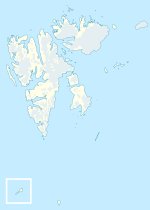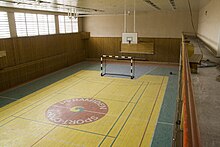Pyramids (Svalbard)
| Pyramids | ||||
|---|---|---|---|---|
|
||||
| Basic data | ||||
| Country | Norway | |||
| Outdoor area | Svalbard | |||
| Coordinates : | 78 ° 39 ′ N , 16 ° 20 ′ E | |||
| Residents : | 16 (July 1, 2013) | |||
Pyramiden ( Russian Пирамида, Piramida ) is a now abandoned and uninhabited mining settlement on Svalbard with over 1000 inhabitants.
Pyramiden is located on the Billefjord, an extension of the Isfjord , about two to three hours by boat northeast of Longyearbyen , in what is known as Dickson Land . The place owes its name to the pyramidal shape of the mountain of the same name, at the foot of which it lies.
history
1921 to 2000
After initially a Swedish company began mining coal in 1921, the rights were acquired by the Soviet Arktikugol trust in the late 1920s . As a signatory to the Svalbard Treaty , the Soviet Union also had the right to mine raw materials on the Norwegian archipelago.
In 1941 the city was evacuated as a protection against the war, but remained completely undestroyed. Since the second Russian coal settlement Barentsburg , which is still in operation today, was practically completely destroyed, Pyramiden was the most important and largest coal mining settlement of the Soviet government in the Arctic after the Second World War . As a result of glasnost , in addition to coal mining, tourism became an important source of income for the city in Pyramiden, and a large hotel was opened.
In the early 1990s, the first residents were sent back to their homeland (mostly Russia or Ukraine ) as coal mining was reduced, and in 1996 most families were no longer there. In 1998 the Russian government decided to shut down coal mining in Pyramiden completely because it was no longer profitable. The last coal wagon drove on March 3, 1998, and in October the city was more or less abandoned in a hurry. Many of the buildings were not even ten years old at the time, as a lot was invested until shortly before the city was abandoned. In 2000, the last residents left the settlement and Pyramiden has been depopulated since then. This makes Barentsburg the only remaining Russian settlement on Svalbard.
At times around 1000 people lived here. This made Pyramiden one of the largest places in Svalbard and in the meantime also the northernmost settlement in the world.
Pyramids today
After the site was abandoned, many buildings were looted and / or damaged in small parts by vandalism; individual buildings were blown up before the site was abandoned. For a long time it was debated what should happen to the place, which is why the decay gnawed at the city for many years. Since around 2007, a handful of workers have been working in pyramids every summer to prevent the city from falling apart and to clean up the area. They then live in the old hotel, which has since been reopened to tourists.
In the summer, Pyramiden is also the destination of organized day trips by boat from Longyearbyen several times a week , and there are city tours where some of the buildings can be entered under supervision. In addition, many tour operators start some of their trekking tours here, as the area is ideal for tours. A couple of base camps are within reach.
Pyramiden is also regularly called at in the summer season by expedition cruise ships from various operators.
In 2018 , the jazz music events were held in the abandoned city as part of the Northern Expo , which was held from October 4 to 7, 2018 in Svalbard.
Life at the time of operation in Pyramiden
Shaping the city
When looking at the pyramid, the typical "east building style" is noticeable, but the beginnings of embellishment of the otherwise rather gloomy-looking concrete buildings can be seen. Most of the buildings are decorated with either bricks or wooden panels and some are colored. The large statue of Lenin in front of the House of Culture and a few surviving communist propaganda symbols are also striking, although the city was still in operation after the fall of the Soviet Union .
There is also something special about the plant design in pyramids. Normally, the Arctic vegetation does not allow the occurrence of many plants, but the operators of Pyramidens imported lawn seeds from Russia, and tall lawns are still growing throughout the city today. However, while the city was in operation, only the cattle and children were allowed on the lawn.
building
Most of the buildings in the city are residential, as a large number of residents lived here. There are also warehouses, cattle sheds, a greenhouse, a hospital, the hotel, a canteen, a culture or community center, a school and a kindergarten, a swimming pool, an electricity station and a large number of buildings that were responsible for coal mining, In other words, administration, workshops and the dismantling buildings themselves. Today, due to the vandalism, the buildings have largely been completed by the government in Spitsbergen and can usually only be viewed during guided tours. A special feature is the somewhat remote bottle house, which was built only from vodka bottles. A fascinating play of colors can be seen when the weather is good, and a “bottle concert” can be heard when the wind is blowing.
The Hotel Tulpan (Tulip) has been renovated and reopened. Overnight stays can be booked.
Residents
The inhabitants of Pyramid were almost exclusively families of miners. Getting to Pyramids was, in a way, a reward for the workers. Only the best workers from different coal settlements in Russia and Ukraine were transferred to Pyramiden and were allowed to work and live there for two years. They then had to return to their homeland and were replaced by other workers. According to reports, life in pyramids was significantly better than in Russia itself, especially during the times of the Soviet Union.
Today 11 people live in Pyramiden in summer, from bus drivers, post office and hotel employees to power station engineers. In the dark season only 2 people live in pyramids. One person takes care of the hotel, the other takes care of the power plant.
The dark season runs from October 26th to February 16th. During this time the sun does not rise. The midnight sun shines from April 18th up to and including August 26th.
leisure
Although the residents only stayed there for two years, there was a lot of life in Pyramiden alongside work. In addition to a soccer and swimming team, there was also a jazz band and various dance and theater groups. Almost all of the free time was spent in the Kulturhaus, as there was a sports hall as well as a ballet hall , an auditorium with a cinema function, various music rooms and a library. In the Kulturhaus there are still pictures of sports teams and various events and performances in the auditorium.
care
Most of the supply could be regulated via pyramids themselves. In addition to a distant reservoir, from where the drinking water was supplied, there was a cattle breeding facility for fresh meat and a greenhouse for fresh vegetables.
gallery
Lenin statue in front of the Sports and Culture House in the central square
Web links
- Angelika Franz: Forgotten Places: Ghost Town in the Ice. Article in Spiegel Online in the portal one day . August 9, 2010.
- Pyramids on the website Yr.no, Norwegian Meteorological Institute and NRK.
Individual evidence
- ↑ Even Høydahl, Øivind Rustad: Population of Svalbard, July 1, 2013. Statistics Norway's Information Center, September 24, 2013, accessed on December 31, 2013 .
- ↑ CNN : Abandoned for 20 years, this Russian ghost town now hosts a unique performance on November 15, 2018
- ↑ Northern Expo 2018 - All About Jazz , accessed November 15, 2018
- ↑ Velkommen til Svalbard - det ect Arctic. Retrieved July 12, 2018 (nb-NO).
- ^ Sunrise and sunset times in Pyramiden, April 2018. Accessed on July 12, 2018 .












